With the help of Zoom and Facetime, I recently paid a virtual studio visit to Megan Marlatt in Orange, Virginia, where she lives in a former commercial building next to the railroad tracks with her husband, photographer Richard Knox Robinson, an Affenpinscher named Giotto and a Japanese Chin named Wasabi. Marlatt’s sunny, colorful funhouse of a studio is on the ground floor with the living quarters above. Primarily a painter, Marlatt is also a professor of Fine Art at the University of Virginia where she has taught for “31 fuckin’ years.” Marlatt is funny, earthy and irreverent, all of which jump out at you from her work and have ensured her status as a beloved teacher. But there is also a deeply questioning side that revels in a profound exploration of ideas. Whether she is dealing with kitchen items, botany, biology, toys and, most recently, the world of masks and European carnival culture, she unites the playfulness and curiosity of a child with conceptual sophistication. So, I was not surprised when the Zoom connection went through, and into the frame stepped, a giant Red Rooster. To be more precise, a rooster “big head” worn by Marlatt.
Sarah Sargent: Well, hello Mr. Rooster. (Marlatt laughs and removes the head.)
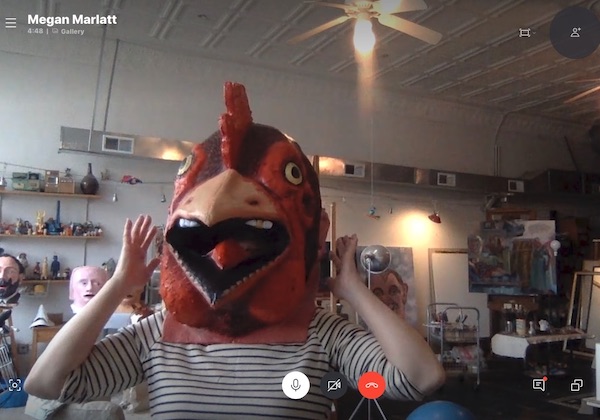
Megan Marlatt: This is my latest big head. You can see, if you turn the head around it’s actually a man wearing a mask. The red rooster is the symbol of Wallonia (French Belgium), so it’s a Wallonian man wearing a rooster mask. It’s a tribute to Binche, Belgium, where I went in 2018 on a Fulbright to study carnival culture. The host institution was the Museum of Carnival and Mask in Binche.
How did you become interested in your form of masks, the big heads?
About 10 years ago, a painter friend, Alex O’Neal, who’d just come back from Barcelona, sent me a photograph of big heads (capgrossos in Catalonian). They put a spell on me and I was instantly smitten. I’d been painting puppet heads. I was trying to see how much life I could project into these puppets’ portraits when I painted them. I realized that’s what an artist and a child have in common, they project life into inanimate objects. Or, they animate them, inserting a little soul, an anima, in them. I was painting the puppets as if they were alive and they were posing for me, and I was Rembrandt and they were my patrons, trying to see how alive I could make them with my paint. But when I saw the pictures of the capgrossos from Spain, I thought, “damn, I don’t have to project a little soul into them, I can just climb on in!”
How did you proceed?
The next step was difficult, because so much of my identity was tied up with being a painter, I didn’t dare think I could make big heads—that would be eek! sculpture, and I didn’t identify with that. So, there ensued internal conversations somewhat like Gollum and Smeagol. “You can’t do that! “I can do that!” When I first went to Spain to meet Ventura and Hosta (folk artists who specialize in capgrossos, I went with the intention of painting THEIR big heads, not making my own. But, the urge was too fierce, I just had to do it. So, I watched videos of their work and read about them and I did some experimenting in my studio, trying to make them on my own, not knowing anything about the folk tradition, OR sculpture. I made a few Frankenstein monsters in the process and had lots of failures. When I finally was able to piece my first heads together, I showed them in an exhibition at Richmond, Virginia’s, Visual Arts Center. The curator, Caroline Cobb Wright applied for a grant from the NEA and with that money was able to bring Ventura and Hosta to America during my show to do workshops with artists at the Visual Arts Center. I then matched funding from UVa to bring them to the University of Virginia where they taught my students. By the end, between all the artists in Richmond and my students in Charlottesville, we had made a whole bunch of big heads. That’s when I realized it wouldn’t be right for everyone to just take their big heads and go home. We had to take it to the next level. So, that’s when the Big Head Brigade was born.
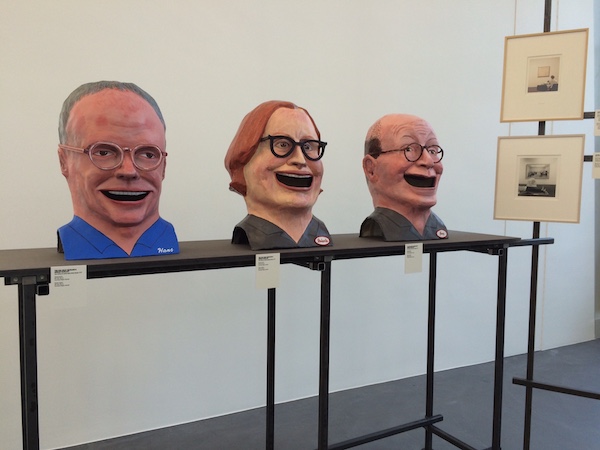
Megan Marlatt, “Critics at Large, Roberta, Jerry and Hans” at Manifesta, 2016.
What is the material?
They are papier–mâché, but it’s not the way most people think of papier–mâché. It’s not the strips of newspaper coated with paste you used in middle-school art class. One builds the form out of ceramic clay first and then casts the clay head in plaster, creating a two-part mold similar to a chocolate mold. Then you use a special paper you can only get in Spain. It’s more like a pulpy cardboard, like what egg crates are made from. You soak it in water, glue it up and then press it into the mold. Once it dries, you pop it out and assemble the two parts. That’s a pretty quick description of it without all the little details and tricks to actually make it work. The end result is a strong but very light weight head with no armature inside—no chicken wire poking you in the eye. The heads weigh only about three pounds each. The killer of this process is the paper. I was lucky to have some shipped to me from Spain before they stopped making it. Yeah, not only did you have to go to Spain to get it, now they don’t make it there anymore. It’s the same paper they use in Valencia, Spain for their floats during Fallas, as well as their giants and big heads. I don’t know what they’ll do now. I’ve tried to find a substitute. It’s been difficult.
How was it moving from two dimensions to making the big heads?
Sometimes it feels good, sometimes it doesn’t. Occasionally, I collaborate on projects with fellow Big Head Brigade member, Ed Miller, who is a fabulous sculptor. We built the giants of James Madison, James Monroe and Edgar Allen Poe together for the UVa Bicentennial event two years ago. I would start the heads in clay and they would look pretty good, from the front, as if it was a painting, and then Ed would come do them over in the round and they would really begin to look like they had volume and gravity. I knew he understood material in three dimensions much better than I did.
What I love about masks (and big heads) is they‘re empathetic. They erase age, species, race, gender. They allow you to play at being someone else, get inside their skin and empathize with their lot. One of the first series of big heads I did was a bunch of Megan Marlatts. There was Megan the artist, wearing a beret, Asian Megan, Frida Kahlo Megan, African American Megan and male Megan.
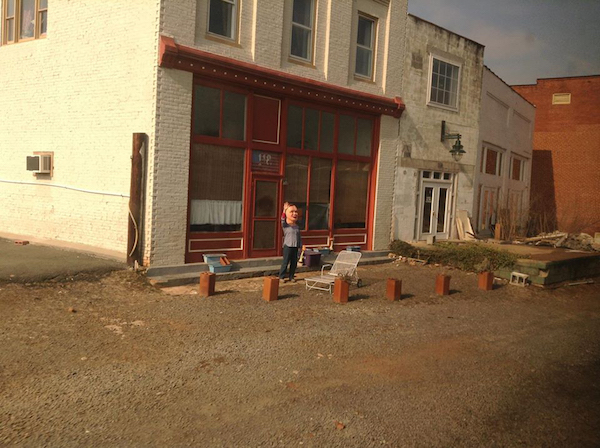
Megan Marlatt outside studio waving at the train.
Were you worried about being perceived as disrespectful?
I guess there’s always that risk although my project was always about the transitional and also empathy. I did make sure the people who wore those big heads, mostly my students, were diverse.
And how does European carnival culture fit in?
Through the big heads, I became very interested in the rituals of European carnivals. For instance, in Binche, the participants carry little brooms which they use to sweep the ground. They’re sweeping away the evils of winter to make way for spring. If they don’t do this ritual, winter will never go away. In Bulgaria, they use sticks to beat the ground, waking spring up. These are pagan rituals adapted by the church. So, lent, a period of fasting, which immediately follows Carnival, coincides with the time when food supplies are running very low. When Carnival occurs, it’s not yet spring, the vernal equinox hasn’t happened. It’s the in-between time when it’s not one thing or the other, and it’s during this liminal period that magic happens.
Oh, that gave me shivers!
Yeah, right? I realized I’m drawn to the liminal, the transitional. It relates to masks where you aren’t one or the other identity and also to my latest work which is temporarily on hiatus because of COVID-19. I’ve been doing a series of paintings of a friend, Christopher a.k.a. Wisteria Ivy, who’s a drag queen and so is living in this transitional world. I generally include a big head in the paintings.
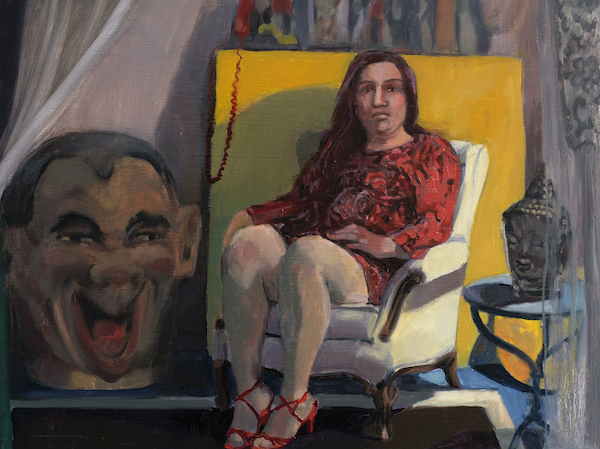
Megan Marlatt, Christopher on Stage
I’ve known your work for a long time. When you first started doing the big heads, it seemed like such a departure, but they led you into the world of carnival which has proved to be such a rich source of inspiration and they continue to figure in your work in this profound and unifying way, blurring the lines between 2-D and 3-D art. You mentioned that the big heads were an outgrowth of your Dutch Masters hand puppet series, but they also seem, in their playfulness, to relate to the series you did with the piles of toys.
I’m still trying to figure this out. The big heads are definitely connected to toys. in fact, many toys were made of the same dense papier–mâché material before the wide spread use of plastic. But the work with toys just had to end. I was bored with it after so many years. It’s one of the nice things about not being famous. No one is financially invested in me painting the same thing over and over again. It’s why when you said my studio looked fun, I said yes, why else would I do this? But, also, even the toys were a sort of proxy for a figure, a character or an actor to play out some sort of narrative or event. I think that’s where I’m heading.
With the Big Head Brigade you have co-opted the parade element of Carnival. Has it been hard to expand your practice to include performance?
I see the big heads as street theater and my paintings as the proscenium stages. In addition to the paintings of my friend Christopher, I’ve also been working on paintings of a day parade and a night parade. The reason being, Carnival is about getting rid of the night force, which is winter and bringing in the day force.
What sorts of events has The Big Head Brigade participated in?
I’m not a theater person, but I took seven big heads worn by me, my husband, Richard, Ed Miller and one student, Jenny Campbell, to the “Tribes” street theater festival in Prague in 2015. To enter the festival, you have to have more than three people and dress similarly. We brought the big heads over on the airplane. They were our checked luggage. We packed our toothbrushes and underwear inside them. They were featured at the 2014 Dumbo Arts Festival in Brooklyn. The “Critics at Large, Roberta, Jerry and Hans” were curated into “The Historical Exhibition, Sites Under Construction” at Manifesta 11 in Zurich during the Summer of 2016. The heads represented Jerry Saltz, Roberta Smith and Swiss art critic, Hans Ulrich Obrist. Originally, there was only Jerry and Roberta, but I added Hans so the piece would resonate more in the foreign setting. “Critics at Large” addressed an important element of Carnival, namely the power switch that occurs. The people who don’t have power, take over and the powerful are made fun of. So, in this context, I’m subjecting these art critics to praise-abuse, because they have the power I don’t have.
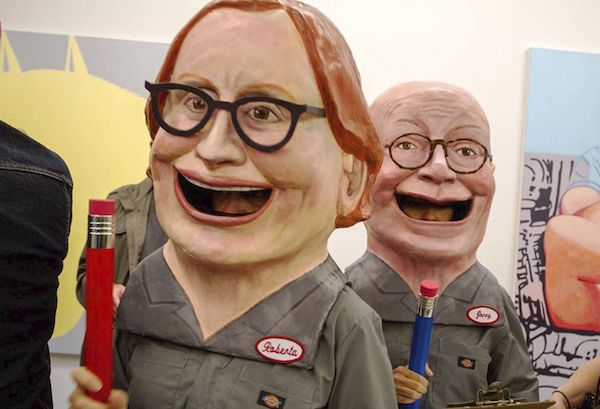
Megan Marlatt, “Roberta and Jerry” in NYC.
Did you ever hear from any of them?
I think Jerry Saltz commented at one point during the Dumbo Festival. They must have seen those heads a few times. The Roberta big head was even featured in an article about them last year in a big German magazine. (Suddeutsche Zietung Magazin, Germany, Number 17, Apr. 26, 2019, page 20.)
So, how are you bearing up during this strange and challenging time?
For the most part, pretty well. Artists are fortunate because we tend to have a rich interior life and we’re always isolating. Of course, I’m upset by the political situation and thinking about people losing their jobs and losing their lives.
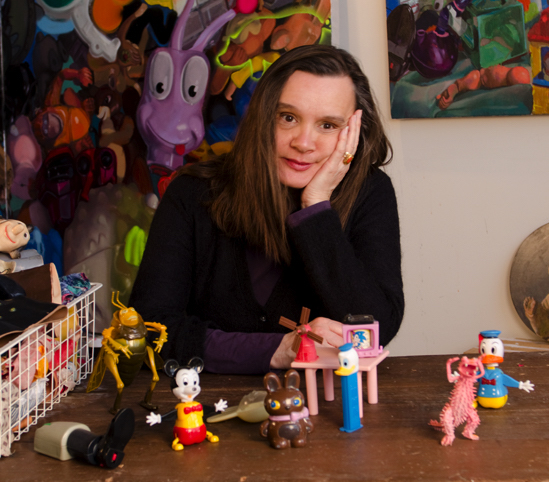
Megan in her studio
Any upsides?
It’s like I’m on an extended artist’s residency. Except, I don’t have anyone to cook for me!



















Megan you’re the greatest! – Dean